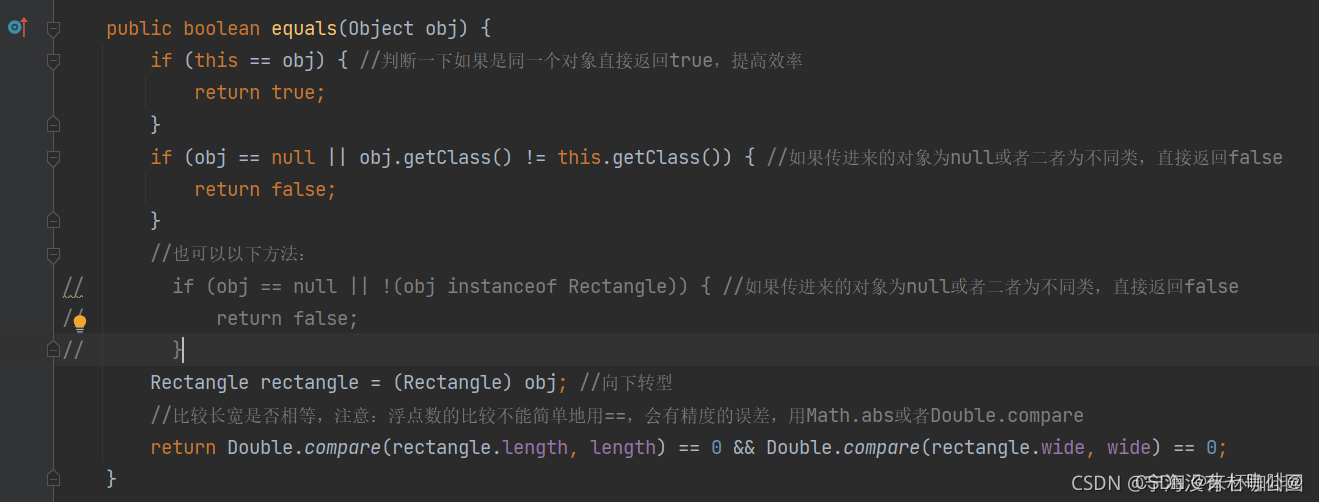【Java基础】重写equals方法详讲_java重写equals方法
赞
踩
一、重写equals方法
1、重写equals方法的两种方式
这里提供两个比较常见的equals重写方法:
● 用instanceof实现重写equals方法
● 用getClass实现重写equals方法
先说结论,getClass()比instanceof更安全。接下来就是我们自己要来实现equals方法了。
2、场景描述
假设有此场景:
在已经创建好的长方形类中重写Object类中的equals方法为当长方形的长和宽相等时,返回TRUE,同时重写hashCode方法,重写toString方法为显示长方形的长宽信息。并测试类。
package com.test10_04;
import java.util.Objects;
class Rectangle {
private double length;
private double wide;
public Rectangle() {
//空实现
}
public Rectangle(double length, double wide) {
setLength(length);
setWide(wide);
}
public double getLength() {
return length;
}
public void setLength(double length) {
assert length > 0.0 : "您的输入有误,长方形的长不能小于0";
this.length = length;
}
public double getWide() {
return wide;
}
public void setWide(double wide) {
assert wide > 0.0 : "您的输入有误,长方形的宽不能小于0";
this.wide = wide;
}
public double area() {
return this.length * this.wide;
}
public double circumference() {
return 2 * (this.wide + this.length);
}
public boolean equals(Object obj) {
if (this == obj) { //判断一下如果是同一个对象直接返回true,提高效率
return true;
}
if (obj == null || obj.getClass() != this.getClass()) { //如果传进来的对象为null或者二者为不同类,直接返回false
return false;
}
//也可以以下方法:
// if (obj == null || !(obj instanceof Rectangle)) { //如果传进来的对象为null或者二者为不同类,直接返回false
// return false;
// }
Rectangle rectangle = (Rectangle) obj; //向下转型
//比较长宽是否相等,注意:浮点数的比较不能简单地用==,会有精度的误差,用Math.abs或者Double.compare
return Double.compare(rectangle.length, length) == 0 && Double.compare(rectangle.wide, wide) == 0;
}
public int hashCode() { //重写equals的同时也要重写hashCode,因为同一对象的hashCode永远相等
return Objects.hash(length, wide); //调用Objects类,这是Object类的子类
}
public String toString() {
return "Rectangle{" + "length=" + length + ", wide=" + wide + '}';
}
}
public class TestDemo {
public static void main(String[] args) {
Rectangle rectangle1 = new Rectangle(3.0, 2.0);
Rectangle rectangle2 = new Rectangle(3.0, 2.0);
System.out.println(rectangle1.equals(rectangle2));
System.out.println("rectangle1哈希码:" + rectangle1.hashCode() +
"\nrectangle2哈希码:" + rectangle2.hashCode());
System.out.println("toString打印信息:" + rectangle1.toString());
}
}
- 1
- 2
- 3
- 4
- 5
- 6
- 7
- 8
- 9
- 10
- 11
- 12
- 13
- 14
- 15
- 16
- 17
- 18
- 19
- 20
- 21
- 22
- 23
- 24
- 25
- 26
- 27
- 28
- 29
- 30
- 31
- 32
- 33
- 34
- 35
- 36
- 37
- 38
- 39
- 40
- 41
- 42
- 43
- 44
- 45
- 46
- 47
- 48
- 49
- 50
- 51
- 52
- 53
- 54
- 55
- 56
- 57
- 58
- 59
- 60
- 61
- 62
- 63
- 64
- 65
- 66
- 67
- 68
- 69
- 70
- 71
- 72
- 73
- 74
- 75
- 76
- 77
- 78
- 79
3、getClass和instanceof优缺点
具体实现思路在代码中讲的很清楚了,我们这里重点分析一下getClass和instanceof两种实现方法的优缺点:

将代码逻辑简化一下:
我们就重点看这段简单的代码
//getClass()版本
public class Student {
private String name;
public void setName(String name) {
this.name = name;
}
@Override
public boolean equals(Object object){
if (object == this)
return true;
// 使用getClass()判断对象是否属于该类
if (object == null || object.getClass() != getClass())
return false;
Student student = (Student)object;
return name != null && name.equals(student.name);
}
- 1
- 2
- 3
- 4
- 5
- 6
- 7
- 8
- 9
- 10
- 11
- 12
- 13
- 14
- 15
- 16
- 17
事实上两种方案都是有效的,区别就是getClass()限制了对象只能是同一个类,而instanceof却允许对象是同一个类或其子类,这样equals方法就变成了父类与子类也可进行equals操作了,这时候如果子类重定义了equals方法,那么就可能变成父类对象equlas子类对象为true,但是子类对象equlas父类对象就为false了,如下所示:
class GoodStudent extends Student {
@Override
public boolean equals(Object object) {
return false;
}
public static void main(String[] args) {
GoodStudent son = new GoodStudent();
Student father = new Student();
son.setName("test");
father.setName("test");
// 当使用instance of时
System.out.println(son.equals(father)); // 这里为false
System.out.println(father.equals(son)); // 这里为true
// 当使用getClass()时
System.out.println(son.equals(father)); // 这里为false
System.out.println(father.equals(son)); // 这里为false
}
}
- 1
- 2
- 3
- 4
- 5
- 6
- 7
- 8
- 9
- 10
- 11
- 12
- 13
- 14
- 15
- 16
- 17
- 18
- 19
- 20
- 21
- 22
- 23
注意看这里用的是getClass()

返回值两个都是false,符合我们的预期,(连类都不一样那肯定得为false啊)

而换成instanceof试试看咯:

运行结果:一个为true一个为false,很明显出现问题了。

这里的原因如下:
instanceof的语法是这样的:
当一个对象为一个类的实例时,结果才为true。但它还有一个特点就是,如果当这个对象是其子类的实例时,结果也会为true。这便导致了上述的bug。也就是说当比较的两个对象,他们的类是父子关系时,instanceof可能会出现问题。需要深究的小伙伴可以自己去了解一哈,所以在这里建议在实现重写equals方法时,尽量使用getClass来实现。
在重写equals方法的同时需要重写hashCode方法,具体原因可能后续会讲到~~
4、instanceof和getClass总结
区别就是getClass()限制了对象只能是同一个类,而instanceof却允许对象是同一个类或其子类,
5、instanceof实战
public class GenericTest01 {
public static void main(String[] args) {
// 使用JDK5之后的泛型机制
// 使用泛型List<Animal>之后,表示List集合中只允许存储Animal类型的数据。
// 用泛型来指定集合中存储的数据类型。
List<Animal> myList = new ArrayList<Animal>();
// 指定List集合中只能存储Animal,那么存储String就编译报错了。
// 这样用了泛型之后,集合中元素的数据类型更加统一了。
//myList.add("abc");
Cat c = new Cat();
Bird b = new Bird();
myList.add(c);
myList.add(b);
// 获取迭代器
// 这个表示迭代器迭代的是Animal类型。
Iterator<Animal> it = myList.iterator();
while(it.hasNext()){
// 使用泛型之后,每一次迭代返回的数据都是Animal类型。
//Animal a = it.next();
// 这里不需要进行强制类型转换了。直接调用。
//a.move();
// 调用子类型特有的方法还是需要向下转换的!
Animal a = it.next();
if(a instanceof Cat) {
Cat x = (Cat)a;
x.catchMouse();
}
if(a instanceof Bird) {
Bird y = (Bird)a;
y.fly();
}
}
}
}
class Animal {
// 父类自带方法
public void move(){
System.out.println("动物在移动!");
}
}
class Cat extends Animal {
// 特有方法
public void catchMouse(){
System.out.println("猫抓老鼠!");
}
}
class Bird extends Animal {
// 特有方法
public void fly(){
System.out.println("鸟儿在飞翔!");
}
}
- 1
- 2
- 3
- 4
- 5
- 6
- 7
- 8
- 9
- 10
- 11
- 12
- 13
- 14
- 15
- 16
- 17
- 18
- 19
- 20
- 21
- 22
- 23
- 24
- 25
- 26
- 27
- 28
- 29
- 30
- 31
- 32
- 33
- 34
- 35
- 36
- 37
- 38
- 39
- 40
- 41
- 42
- 43
- 44
- 45
- 46
- 47
- 48
- 49
- 50
- 51
- 52
- 53
- 54
- 55
- 56
- 57
- 58
- 59
- 60
- 61
- 62


